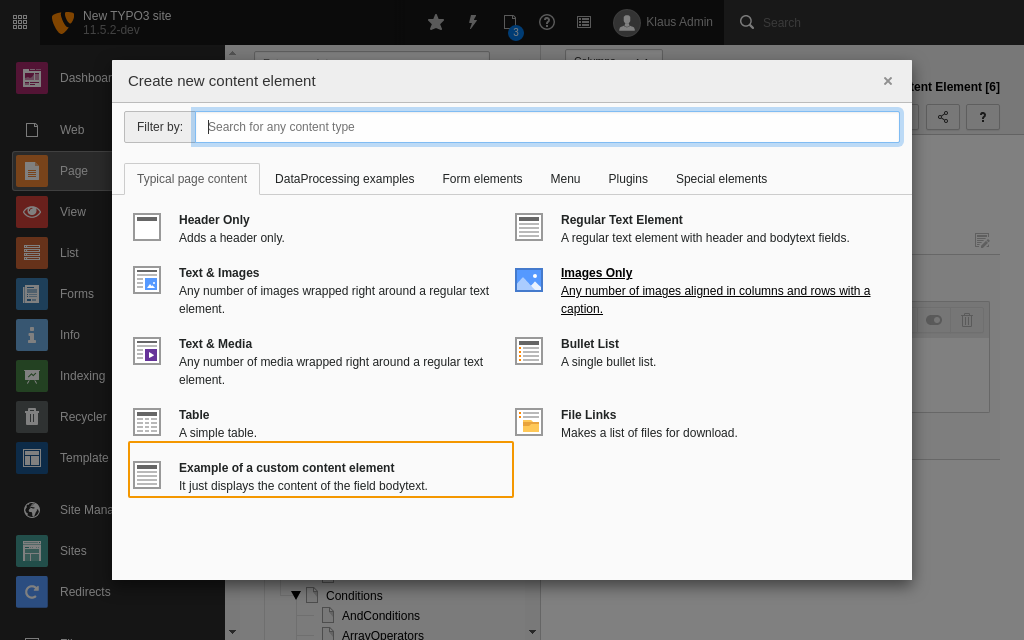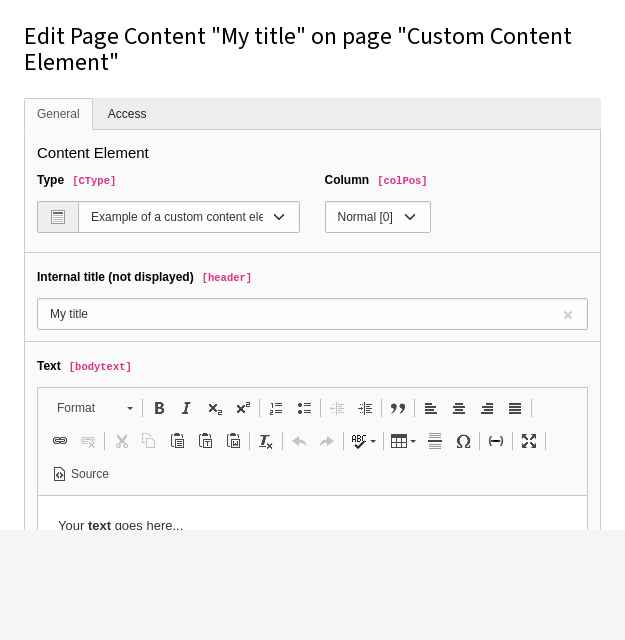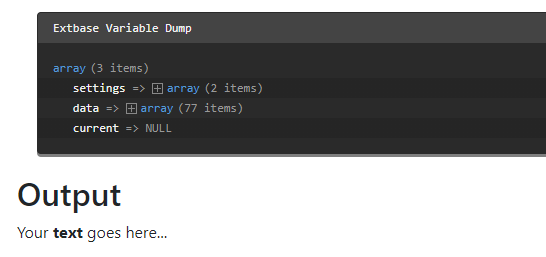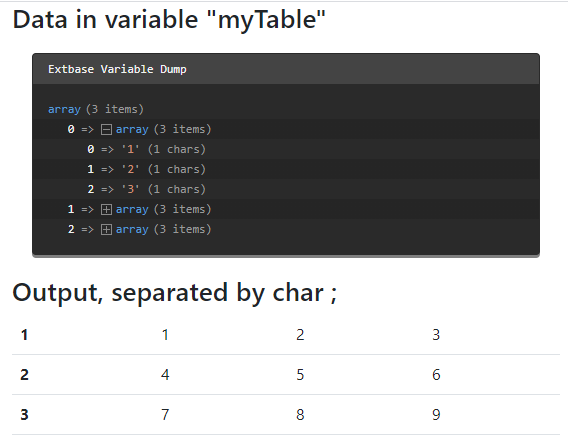Attention
TYPO3 v11 has reached end-of-life as of October 31th 2024 and is no longer being maintained. Use the version switcher on the top left of this page to select documentation for a supported version of TYPO3.
Need more time before upgrading? You can purchase Extended Long Term Support (ELTS) for TYPO3 v11 here: TYPO3 ELTS.
Create a custom content element type
This page explains how to create your own custom content element types. These
are comparable to the predefined content element types supplied by TYPO3. The latter
can be found in the system extension fluid_.
A content element can be based on fields already available in the tt_
table.
It is also possible to add extra fields to the tt_
table, see Extending tt_content.
The data of the content element is then passed to a TypoScript object, in most cases to a FLUIDTEMPLATE.
Some data might need additional Data processing. Data processors are frequently used for example to process files (FilesProcessor) or to fetch related records (DatabaseQueryProcessor).
A data processor can also be used to convert a string to an array,
as is done for example in the table content element with the field bodytext.
In these cases Fluid does not have to deal with these manipulations or transformation.
You can find the example below in the TYPO3 Documentation Team extension examples.
Prerequisites
The following examples require the system extension fluid_styled_content.
It can be installed via Composer with:
composer req typo3/cms-fluid-styled-contentUse an extension
We recommend to create your own extension for new custom content element types.
The following example uses the extension key examples.
Here you can find information on how to create an extension.
Register the content element type
First we need to define the key of the new content element type. We use
examples_ throughout the simple example.
Next the key needs to be added to the select field CType. This will make it
available in Type dropdown in the backend.
The following call needs to be added to the file
Configuration/.
<?php
// Adds the content element to the "Type" dropdown
\TYPO3\CMS\Core\Utility\ExtensionManagementUtility::addTcaSelectItem(
'tt_content',
'CType',
[
// title
'LLL:EXT:examples/Resources/Private/Language/locallang.xlf:examples_newcontentelement_title',
// plugin signature: extkey_identifier
'examples_newcontentelement',
// icon identifier
'content-text',
],
'textmedia',
'after'
);
// Adds the content element icon to TCA typeicon_classes
$GLOBALS['TCA']['tt_content']['ctrl']['typeicon_classes']['myextension_newcontentelement'] = 'content-text';
// ...Now the new content element is available in the backend form. However it currently contains no fields but the CType field.

CType dropdown in tt_content
About the icon
You can either use an existing icon from the TYPO3 core or register your
own icon using the Icon API. In this example we use the icon
content-, the same icon as the Regular Text Element uses.
Add it to the new content element wizard
Content elements in the New Content Element Wizard are easier to find for editors. It is therefore advised to add the new content element to this wizard (via page TSconfig).
mod.wizards.newContentElement.wizardItems {
// add the content element to the tab "common"
common {
elements {
examples_newcontentelement {
iconIdentifier = content-text
title = LLL:EXT:examples/Resources/Private/Language/locallang.xlf:examples_newcontentelement_title
description = LLL:EXT:examples/Resources/Private/Language/locallang.xlf:examples_newcontentelement_description
tt_content_defValues {
CType = examples_newcontentelement
}
}
}
show := addToList(examples_newcontentelement)
}
}
Content element wizard with thCTypee new content element
The content element wizard configuration is described in detail in Add content elements to the Content Element Wizard.
Configure the backend form
Then you need to configure the backend fields for your new content element in
the file Configuration/:
// Configure the default backend fields for the content element
$GLOBALS['TCA']['tt_content']['types']['examples_newcontentelement'] = [
'showitem' => '
--div--;LLL:EXT:core/Resources/Private/Language/Form/locallang_tabs.xlf:general,
--palette--;;general,
header; Internal title (not displayed),
bodytext;LLL:EXT:frontend/Resources/Private/Language/locallang_ttc.xlf:bodytext_formlabel,
--div--;LLL:EXT:core/Resources/Private/Language/Form/locallang_tabs.xlf:access,
--palette--;;hidden,
--palette--;;access,
',
'columnsOverrides' => [
'bodytext' => [
'config' => [
'enableRichtext' => true,
'richtextConfiguration' => 'default',
],
],
],
];Now the backend form for the new content elements looks like this:

The backend form
Configure the frontend rendering
The output in the frontend gets configured in the setup TypoScript. See Add TypoScript to your extension about how to add TypoScript.
In the examples extension the TypoScript can be found at
Configuration/
The Fluid templates for our custom content element will be saved in our extension. Therefore we need to add the path to the Properties:
lib.contentElement {
templateRootPaths.200 = EXT:examples/Resources/Private/Templates/
}You can use any index (200 in this example), just make sure it is unique.
If needed you can also add paths for partials and layouts.
Now you can register the rendering of your custom content element:
tt_content {
examples_newcontentelement =< lib.contentElement
examples_newcontentelement {
templateName = NewContentElement
}
}The
lib. path is defined in file
EXT:.
and uses a FLUIDTEMPLATE.
We reference fluid_styled_contents
lib. from our new content element and only change
the Fluid template to be used.
The Fluid template is configured by the
Properties property as
New.
This will load a New template file from the path
defined at the
template.
In the example extension you can find the file at
EXT:
tt_ fields can now be used in the Fluid template by accessing them via the data variable.
The following example shows the text entered in the richtext enabled field bodytext, using the html
saved by the richtext editor:
<html data-namespace-typo3-fluid="true"
xmlns:f="http://typo3.org/ns/TYPO3/CMS/Fluid/ViewHelpers">
<h2>Data available to the content element: </h2>
<f:debug inline="true">{_all}</f:debug>
<h2>Output</h2>
<div><f:format.html>{data.bodytext}</f:format.html></div>
</html>All fields of the table
tt_ are now available in the variable
data. Since we saved the content of bodytext in the richt text editor we
have to run it through f: to resolve all links and other
formatting. Read more about Fluid.
Tip
During development you can output all available variables in a Fluid
template by adding
<f:.
Even more convenient:
<f:
lets you easily turn debugging on or off, depending on whether you
fill in "1" or "0" for condition.
<f:if condition="1"><f:debug>{settings}</f:debug></f:if>
<f:if condition="0"><f:debug>{data}</f:debug></f:if>
<f:if condition="1"><f:debug>{current}</f:debug></f:if>Below you can see the example output of the new content element and a dump of all available data:

Extended example: Extend tt_content and use data processing
You can find the complete example in the TYPO3 Documentation Team extension examples. The steps for creating a simple new content element as above need to be repeated. We use the key examples_newcontentcsv in this example.
We want to output comma separated values (CSV) stored in the field bodytext. As different programs use different separators to store CSV we want to make the separator configurable.
Extending tt_content
If the available fields in the table tt_content are not sufficient you can add
your own fields. In this case we need a field
tx_ from
which to choose the desired separator.
Extending the database schema
First we extend the database schema by adding the following to the file
ext_:
CREATE TABLE tt_content (
tx_examples_separator VARCHAR(255) DEFAULT '0' NOT NULL,
);Tip
Remember to do a database compare in the Install Tool after changing the database schema.
Defining the field in the TCA
The new field tx_examples_separator is added to the TCA definition of the table tt_content in the file
Configuration/:
$temporaryColumn = [
'tx_examples_separator' => [
'exclude' => 0,
'label' => 'LLL:EXT:examples/Resources/Private/Language/locallang_db.xlf:tt_content.tx_examples_separator',
'config' => [
'type' => 'select',
'renderType' => 'selectSingle',
'items' => [
['Standard CSV data formats', '--div--'],
['Comma separated', ','],
['Semicolon separated', ';'],
['Special formats', '--div--'],
['Pipe separated (TYPO3 tables)', '|'],
['Tab separated', "\t"],
],
'default' => ','
],
],
];
\TYPO3\CMS\Core\Utility\ExtensionManagementUtility::addTCAcolumns('tt_content', $temporaryColumn);You can read more about defining fields via TCA in the TCA Reference.
Now the new field can be used in your Fluid template just like any other tt_content field.
Another example shows the connection to a foreign table. This allows you to be
more flexible with the possible values in the select box. The new field
tx_ is a connection to the TYPO3 system category
table
sys_:
'tx_examples_main_category' => [
'exclude' => 0,
'label' => 'LLL:EXT:examples/Resources/Private/Language/locallang_db.xlf:tt_content.tx_examples_main_category',
'config' => [
'type' => 'select',
'renderType' => 'selectSingle',
'items' => [
['None', '0'],
],
'foreign_table' => 'sys_category',
'foreign_table_where' => 'AND {#sys_category}.{#pid} = ###PAGE_TSCONFIG_ID### AND {#sys_category}.{#hidden} = 0 ' .
'AND {#sys_category}.{#deleted} = 0 AND {#sys_category}.{#sys_language_uid} IN (0,-1) ORDER BY sys_category.uid',
'default' => '0'
],
],Defining the field in the TCE
An individual modification of the newly added field tx_examples_main_category to the TCA definition of the table tt_content can be done in the TCE (TYPO3 Core Engine) TSConfig. In most cases it is necessary to set the page id of the general storage folder. Then the examples extension will only use the content records from the given page id.
TCEFORM.tt_content.tx_examples_main_category.PAGE_TSCONFIG_ID = 18If more than one page id is allowed, this configuration must be used instead (and the above TCA must be modified to use the marker ###PAGE_TSCONFIG_IDLIST### instead of ###PAGE_TSCONFIG_ID###):
TCEFORM.tt_content.tx_examples_main_category.PAGE_TSCONFIG_IDLIST = 18, 19, 20<h2>Content separated by sign {data.tx_examples_separator}</h2>Note
As we are working with pure Fluid without Extbase here the new fields can be used right away. They need not be added to a model.
Data processing
Data processors can be used for data manipulation or fetching before the variables get passed on to the template.
This is done in the dataProcessing section where you can add an arbitrary number of data processors.
You can see a complete list of available data processors in the Typoscript Reference or write a custom data processor.
Each processor has to be added with a fully qualified class name and optional parameters to be used in the data processor:
tt_content {
examples_newcontentcsv =< lib.contentElement
examples_newcontentcsv {
templateName = DataProcCsv
dataProcessing.10 = TYPO3\CMS\Frontend\DataProcessing\CommaSeparatedValueProcessor
dataProcessing.10 {
fieldName = bodytext
fieldDelimiter.field = tx_examples_separator
fieldEnclosure = "
maximumColumns.field = imagecols
as = myTable
}
}
}You can now iterate over the variable my in the Fluid template, in this
example Resources/
<html data-namespace-typo3-fluid="true" xmlns:f="http://typo3.org/ns/TYPO3/CMS/Fluid/ViewHelpers">
<h2>Data in variable "myTable"</h2>
<f:debug inline="true">{myTable}</f:debug>
<h2>Output, {data.imagecols} columns separated by char {data.tx_examples_separator}</h2>
<table class="table table-hover">
<f:for each="{myTable}" as="columns" iteration="i">
<tr>
<th scope="row">{i.cycle}</th>
<f:for as="column" each="{columns}">
<td>{column}</td>
</f:for>
<tr>
</f:for>
</table>
</html>The output would look like this (we added a debug of the variable my):

